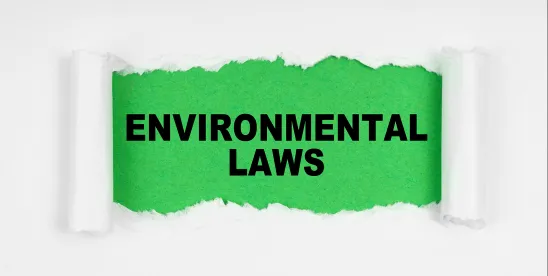Last week’s unexpected opinion of the U.S. Court of Appeals for the D.C. Circuit (“DC Circuit”) holding that the Council for Environmental Quality (“CEQ”) lacks authority to promulgate regulations implementing the National Environmental Policy Act (“NEPA”) leaves federal agencies and private projects facing tremendous uncertainty and likely delays in completing environmental reviews. In Marin Audubon Society v. Federal Aviation Administration, No. 23-1067 (D.C. Cir. Nov. 12, 2024), a divided panel ruled, nearly five decades after CEQ first adopted regulations directing federal agencies’ compliance with NEPA, that the CEQ’s rules are ultra vires because Congress has never given CEQ such rulemaking authority. With many agencies explicitly incorporating the CEQ rules into their own NEPA regulations, the opinion not only calls into question the proper methods for NEPA analysis, but also casts doubt on hundreds of completed and pending environmental reviews that have relied on the CEQ regulations.
Summary of Opinion
Marin Audubon Society involved a challenge to the Federal Aviation Administration’s and National Park Service’s joint NEPA review of an Air Tour Management Plan (“Plan”) regulating commercially operated tourist flights over four National Parks. Compliance with the CEQ’s NEPA regulations was an issue in the case, but a majority of the appellate panel surprised the litigants and the legal community by reaching beyond that issue and ruling, sua sponte, that CEQ lacked authority to promulgate the NEPA regulations in the first place. The panel then concluded, without relying on the CEQ regulations, that the agencies’ environmental review violated NEPA by using an “improper baseline” for analysis. While agreeing with the majority to vacate the agencies’ NEPA determination, Justice Srinivasan dissented, arguing the court had no reason to consider CEQ’s underlying authority to promulgate its NEPA regulations because no party had raised the issue.
The status of the CEQ regulations remains unclear following the DC Circuit’s opinion. The opinion vacated and remanded the agencies’ Air Tour Management Plan, while inviting the parties to move for a stay to keep the Plan in place pending a new NEPA review. But the opinion did not explicitly order vacatur of the CEQ regulations, and CEQ was not a party to the appeal.
Implications of Decision
The DC Circuit holding leaves federal agencies in limbo when it comes to implementing NEPA, thereby impeding the environmental review of myriad projects. Some agencies largely rely on the CEQ regulations for NEPA compliance, without incorporating the CEQ rules into their own NEPA regulations. The DC Circuit opinion clearly rejects this approach, but it leaves open the possibility that such agencies may consider the CEQ regulations as guidance. Other agencies have adopted or incorporated by reference the CEQ rules into their own NEPA regulations; the DC Circuit opinion calls it a “good question” whether this is a permissible exercise of those agencies’ rulemaking authority.
In either case, federal agencies attempting to implement NEPA now face a minefield of legal issues, not only related to their reliance on the CEQ regulations, but also based on the unavailability of Chevron deference under the U.S. Supreme Court’s decision in Loper Bright Enterprises v. Raimondo, 603 U.S. ___, 144 S. Ct. 2244 (2024). Even assuming the authority of CEQ to issue judicially enforceable regulations, the DC Circuit in Marin Audubon Society specifically stated that the CEQ regulations are no longer entitled to substantial deference after Loper Bright. Should any federal agency repromulgate its NEPA regulations, whether or not using the CEQ regulations as guidance, the regulations will be reviewed under the less deferential standard set forth in Loper Bright. These factors, together, leave individual agencies’ NEPA regulations and their project-specific NEPA compliance doubly vulnerable to challenge under the Administrative Procedure Act.
There are already new challenges to use of the CEQ regulations based on Marin Audubon Society. Rio Grande LNG LLC has urged the DC Circuit to reconsider its recent ruling in City of Port Isabel v. FERC (No. 23-1175 (August 6, 2024)), which vacated the Federal Energy Regulatory Commission’s (“FERC”) authorization of two natural gas projects citing its failure to comply with CEQ regulations. In State of Iowa v. CEQ, No. 1:2024-cv-00089, Dist. North Dakota, a challenge to the most recent CEQ regulations adopted in 2024, petitioners have now asked the district court to consider Marin Audubon Society as a basis to invalidate the CEQ rules.[1] The issue of CEQ’s rulemaking authority was not raised originally in either case.
The fate of Marin Audubon Society itself is far from settled, of course. A party may move for rehearing en banc, or petition the Supreme Court for review, although it is uncertain whether the incoming administration will choose to defend CEQ’s rulemaking authority. The panel’s opinion itself may also be an invitation to the Supreme Court to consider a similar ruling. This term, the Supreme Court will hear the appeal of Seven County Infrastructure Coalition v. Eagle County, Colorado, 82 F.4th 1152 (D.C. Cir. 2023). In that case, the DC Circuit found the federal Surface Transportation Board’s environmental review of a Utah rail project to be insufficient under NEPA, as interpreted by CEQ regulations. It is not difficult to imagine the current Supreme Court deciding that CEQ lacks the authority to promulgate those regulations.
Going Forward
The silver lining here for federal agencies is that Congress amended NEPA itself as part of a permitting reform effort in the Fiscal Responsibility Act of 2023 (Public Law 118-5 (June 3, 2023), Division C, Title III), which aimed, in part, to codify and streamline how NEPA has been implemented over the last 50 years under the CEQ regulations. Aspects of the CEQ regulations were incorporated into the statutory language. Therefore, those statutory requirements, though limited, remain to guide agency environmental review in the absence of the CEQ regulations and should inform the promulgation of new agency regulations as may be required.
In view of the NEPA amendments, CEQ recently revamped its regulations (89 Fed. Reg. 35442 (May 1, 2024; effective July 1, 2024)). The regulations include other directives beyond the statutory amendments, including a much-touted mandate to consider environmental justice concerns as part of NEPA’s environmental review process. In fact, City of Port Isabel was based on FERC’s failure to address environmental justice in its NEPA review. Those provisions and others that are not specifically addressed in the statutory amendments may be lost indefinitely.
Given the possibility of further judicial review, the imminent change in federal administrations and the potential for further rulemaking by individual agencies, uncertainty will be the only constant for NEPA implementation in the short term. Project proponents requiring federal funding or approval should anticipate possible delays and work closely with legal counsel to evaluate options and minimize risk.
FOOTNOTES
[1] The CEQ first promulgated NEPA regulations in 1978, and they were virtually unchanged until the last administration revised them in 2020 (85 Fed Reg. 43304 (July 16, 2020)). The current administration then revised the regulations again in 2021 (86 Fed. Reg. 55757 (October 7, 2021)), 2022 (87 Fed Reg. 23453 ((April 20, 2022)), and most recently in 2024 (89 Fed. Reg. 35442 (May 1, 2024; effective July 1, 2024)). Virtually all other federal agency regulations implementing NEPA were promulgated before the most recent CEQ rules.




 />i
/>i

